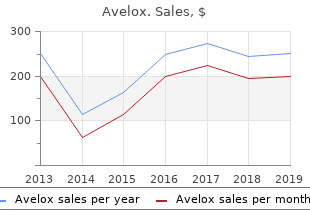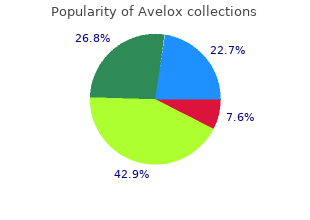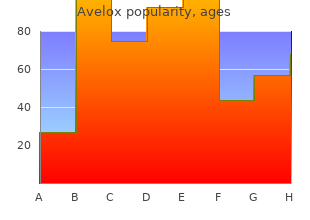Avelox
"Avelox 400 mg without prescription, treatment depression."
By: Stephen M. Rosenthal MD
- Professor of Pediatrics, Associate Program Director, Pediatric Endocrinology
- Director, Pediatric Endocrine outpatient Services, University of California, San Francisco

https://profiles.ucsf.edu/stephen.rosenthal
In areas the place limited research particular to cheap 400 mg avelox stroke was available, studies including individuals with other acceptable, usually neurological, conditions had been used. By necessity the paragraph is temporary, but justifies the suggestions and clarify the link to the first evidence or the reason for skilled consensus being used as an alternative. All studies that had been likely to outcome in the development of a recommendation had been assessed by a second reviewer to guarantee consistency and reproducibility. The ‘Evidence to suggestions’ sections of the rule clarify the balanced rationale behind a call on whether to make a recommendation or not, significantly for contentious areas, and acknowledges areas of uncertainty. Principal concerns for any intervention had been the health advantages to individuals with stroke, balanced towards risks and potential antagonistic effects. In the numerous areas of essential clinical apply the place evidence was not available or uncertain, the Working Party made consensus suggestions based mostly on a collective view, but also drawing on any other related consensus statements, professional pointers or suggestions. The high quality and power of evidence supporting any recommendation was mentioned in a gathering of the subject subgroup, chaired by the subject lead and overseen by the subject editor. Lay members contributed to the subgroup conferences, reviewed the outputs and advised amendments. A draft recommendation was agreed, which was then submitted to the Working Party for approval or wider dialogue as essential. Responsibility for the ultimate adjudication of unresolved issues lay with the three editors and the Working Party chair, with voting as essential. Although superficially appealing, this system introduces potential bias in the utility of the evidence, significantly in relation to complex areas of clinical apply. Methodologically strong evidence for less essential interventions gives the linked recommendation an apparently higher priority than a vital recommendation the place the evidence is weaker. The power depends solely upon the study design and ignores other essential options of the evidence similar to its plausibility, generalisability, and absolutely the profit to the total population of people with stroke. For this guideline, as with previous editions, the Working Party has not adopted a hierarchical grading system for the ‘power’ of suggestions. Instead, once all the suggestions had been finalised, a proper consensus approach was used to determine the key suggestions in terms of their wider impact on stroke, and these are listed in the ‘Key Recommendations’ section. In some cases, the evidence base offered adequate information about cost-effectiveness to permit a health economic consideration and the place this has been possible it has been included. Some of the new and current suggestions on this guideline will have vital resource implications, and any organisational or financial barriers to implementation are recognized throughout the linked ‘Implications’ sections so that commissioners and clinical networks can consider the means for local and regional implementation and service re-design. Changes had been made to the rule following dialogue of the collated responses at a full assembly of the Working Party. Grateful thanks are because of the stakeholders (listed in Appendices) who took so much effort and time to give the good thing about their data and expertise in improving the rule before ultimate publication. No exterior funding was acquired or sought from any statutory, business or voluntary physique, and the Working Party retains full editorial independence over the rule development course of and content material.

With median follow up of solely 21 months cheap avelox 400mg amex, the two year relapse-free survival was 85%, and there have been no grade three or greater toxicities. With a 38-month median follow up, the two-year native management rate was ninety one%, with an in-subject recurrence creating on the completion of proton therapy in 1 affected person with pure killer/T-cell lymphoma, while no grade three toxicities were noticed inside the remainder of the cohort. There were no grade three toxicities, and no recurrences famous with solely 7 months median follow up. Among 35 sufferers treated up to now with a median follow-up period of 10 months, no grade three toxicities or grade 2 pneumonitis have been noticed. Furthermore, solely two sufferers had disease relapse and each of those occurred exterior of the proton subject. The outcomes with customary photon-primarily based treatment are usually very favorable, with good native management and restricted toxicity. The potential for discount in long-time period unwanted side effects by decreasing the low-dose exposure of organs at risk will take years or a long time to properly evaluate. While their data shows a lower risk of second malignancies in the proton group (5. Until adequate follow-up is available to conduct such studies, assessment of the dangers depends on risk projection studies or theoretical fashions. Two thousand six hundred fifty-eight (2658) sufferers treated over three years were followed over 10 years. Intensity-modulated proton therapy, volumetric-modulated arc therapy, and 3D conformal radiotherapy in anaplastic astrocytoma and glioblastoma: a dosimetric comparability. A systematic evaluate of proton therapy in the treatment of chondrosarcoma of the cranium base. Projected second tumor risk and dose to neurocognitive constructions after proton versus photon radiotherapy for benign meningioma. Neutron equivalent doses and associated lifetime most cancers incidence dangers for head & neck and spinal proton therapy. Definitive proton radiation therapy and concurrent cisplatin for unresectable head and neck adenoid cystic carcinoma: a sequence of 9 cases and a crucial evaluate of the literature. Incidence of second malignancies amongst sufferers treated with proton versus photon radiation. Prospective evaluation of hypofractionation proton beam therapy with concurrent treatment of the prostate and pelvic nodes for clinically localized, excessive risk or unfavorable intermediate risk prostate most cancers. Early toxicity in sufferers treated with postoperative proton therapy for domestically advanced breast most cancers. Stereotactic fractionated radiotherapy for chordomas and chondrosarcomas of the cranium base. T011: Proton radiotherapy for mediastinal Hodgkin lymphoma: single institution expertise (abstract). Life, liberty, and the pursuit of protons: an evidence-base evaluate of the function of particle therapy in the treatment of prostate most cancers. Eye-sparing multidisciplinary strategy for the administration of lacrimal gland carcinoma.

Proton beam stereotactic radiosurgery for pediatric cerebral arteriovenous malformations avelox 400mg with amex. Proton beam radiosurgery for vestibular schwannoma: tumor control and cranial nerve toxicity. Visual consequence of accelerated fractionated radiation for advanced sinonasal malignancies using photons/protons. Spot-scanning proton radiation therapy for recurrent, residual or untreated intracranial meningiomas. Spot scanning proton therapy in the curative therapy of adult sufferers with sarcoma: the Paul Scherrer Institute expertise. Results of spot-scanning proton radiation therapy for chordoma and chondrosarcoma of the cranium base: the Paul Scherrer Institut expertise. Spot scanning-based proton therapy for intracranial meningioma: long-term results from the Paul Scherrer Institute. Benign meningioma: partially resected, biopsied, and recurrent intracranial tumors handled with combined proton and photon radiotherapy. Comparison of episcleral plaque and proton beam radiation therapy for the therapy of choroidal melanoma. Surveillance of craniopharyngioma cyst growth in youngsters handled with proton radiotherapy. Proton radiotherapy as an alternative choice to extenteration in the management of prolonged conjunctival melanoma. Technology perception: proton beam radiotherapy for therapy in pediatric mind tumors. Standard fractionation low-dose proton radiotherapy for diffuse choroidal hemangiomas in pediatric Sturge-Weber syndrome. Proton-beam, intensity-modulated, and/or intraoperative electron radiation therapy combined with aggressive anterior surgical resection for retroperitoneal sarcomas. Proton versus intensity-modulated radiotherapy for prostate cancer: patterns of care and early toxicity. Proton beam therapy as a nonsurgical strategy to mucosal melanoma of the head and neck: a pilot research. Proton beam therapy for unresectable malignancies of the nasal cavity and paranasal sinuses. Comparison of conventional-dose vs high-dose conformal radiation therapy in clinically localized adenocarcinoma of the prostate: a randomized controlled trial. Rooted in the collaborative work of centers worldwide, the definition and grading of tumors continually evolves to mirror present findings and knowledge including incorporation of genetic profiles. The scale ranges in 10-point increments from 100 (regular exercise with none special care) to zero (useless). Intermediate factors balance a patient’s care wants with his/her capacity to perform regular activities. The scale ranges from zero (absolutely lively) to 5 (useless) with the intermediate grades as described beneath.
Buy 400 mg avelox with amex. Erectile Dysfunction Treatment | Isochronic Binaural Beats Meditation.
Weak Recommendation In children with arterial ischaemic stroke secondary to cheap avelox 400 mg on-line cardioembolism treatment with low molecular weight heparin or Vitamin K antagonist is beneficial for no less than three months. Weak Recommendation In children with arterial ischaemic stroke secondary to dissection, treatment with low molecular weight heparin or Vitamin K antagonist is beneficial for no less than 6 weeks. Ongoing treatment should be dependent on neuro radiological assessment of stenosis severity and recurrent ischaemic episodes. Once the sutures fuse and the cranium is with combined involvement of cortex, white matter and basal closed, the relatively larger proportion of intracranial quantity ganglia (171). Although figuring out which children will go on to develop raised intracranial pressure on account of a stroke is difcult, early recognition is essential to efective management. Initial pressure may be difcult and requires a high level of scientific supportive care contains admission to an intensive care setting, suspicion. The most necessary indicators for raised intracranial 30 levels elevation of the pinnacle of the bed, good pressure with each supra and infratentorial infarcts are oxygenation, adequate hydration and upkeep of deteriorating level of consciousness and the worsening of euvolaemia, nil oral consumption, temperature management (avoiding neurologic dysfunction. Large quantity and multiple posterior fossa strokes, the degree of mass efect on imaging and decrease cranial nerve dysfunction may assist predict progression and elevated intracranial pressure in adults (262, 263). Recognition of intracranial pressure related to actue stroke Strong Recommendation Early recognition of the minority of paediatric sufferers with acute stroke who could develop raised intracranial pressure ought to immediate preliminary supportive care and early neurosurgical referral for consideration of decompressive craniectomy. Practice Statement the most important indicators for raised intracranial pressure with each supra and infratentorial infarcts are deteriorating level of consciousness and worsening of neurologic dysfunction. Due to the small space between the cranial vault and mind parenchyma children with giant infarcts require close monitoring for indicators and signs of raised intracranial pressure in the days following the stroke. Practice Statement Initial supportive care contains intensive neurological surveillance, 300 elevation of the pinnacle of the bed, good oxygenation, adequate hydration and upkeep of euvolaemia, nil oral consumption, temperature management (avoiding hyperthermia), prevention of hypotension but toleration of mild hypertension and management of seizures. Practice Statement Early neurosurgical referral is necessary for consideration of decompressive craniectomy and placement of intracranial pressure measuring devices. Increased intracranial pressure decreases cerebral blood fow and impairs cerebral perfusion pressure, which inhibits Suboccipital decompressive craniectomy in sufferers with oxygenation of wholesome/non-ischaemic mind tissue. The main posterior circulation ischaemic stroke and raised intracranial purpose of decompressive surgery is to take away a part of the pressure should also be thought-about. Taken together, these knowledge additionally indicate the need reviews (261, 274-276) report efective discount of raised for close scientific observation in the frst few days after stroke to intracranial pressure after decompressive craniectomy. One relevant paediatric paper identifed four mortality with an absolute discount in risk of death of about children with space-occupying cerebral oedema attributed to 50% in comparison with medical treatment alone. They additionally present extreme ischaemic infarction of the posterior cerebral arterial general improved incapacity measured by modifed Rankin Scale, circulation and echoes the adult observations detailed although the info recommend that surgical intervention decreased above (278). Younger age and surgical intervention throughout the frst 48 hours (perhaps extra marked with surgery throughout the frst 24 hours or Australian Childhood Stroke Advisory Committee 37 Given the likelihood that extra paediatric stroke sufferers might be Intra and submit-operative issues treated with emergent thrombolysis in the future, the efciency of decompressive craniectomy submit-acute treatment is relevant. There are currently no paediatric studies assessing the efcacy There are currently no printed paediatric studies that or timing of monitoring intracranial pressure in the setting of handle this question. The research was not aimed at assessing consequence, but based on frst principals, improved treatment of raised intracranial pressure Efcacy in children would be anticipated to enhance and not worsen consequence. Adult There is a rising physique of low-level evidence suggesting literature additionally means that monitoring intracranial pressure is decompressive craniectomy could present increased beneft in useful in guiding therapy and improves brief-time period survival in children in comparison with adults.

